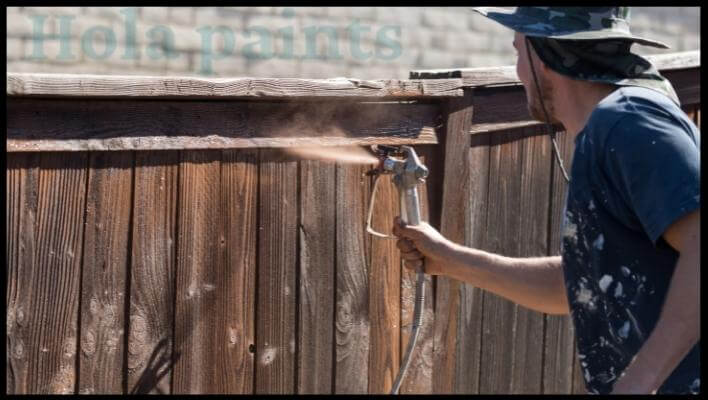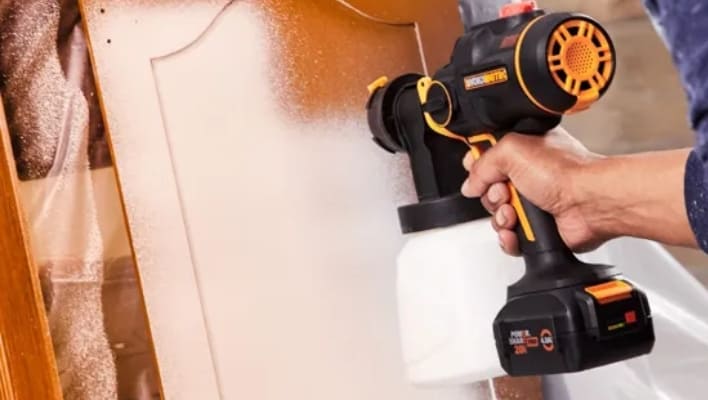Have you ever experienced a hard time choosing the right spray gun? Certainly, you are not the only one struggling with this problem. Even sometimes, highly experienced DIYers and professionals have difficulty choosing the right type of spray gun. However, understanding the main differences between HVLP vs LVLP will make the decision easier for you.
An HVLP or LVLP sprayer are great choices for homeowners and professionals. Though they look the same, they produce different results and applications. Their design helps prevent physical discomfort or fatigue when working long hours.
Are you now wondering whether an HVLP spray gun is better than an LVLP spray gun?
Well, we want to share our experience regarding HVLP vs LVLP with you in the following guide. It will help you to choose between the HVLP vs LVLP spray guns for your pro finishing project.
Table of Contents
- LVLP vs HVLP Spray Gun Differences
- HVLP Meaning
- HVLP Turbines
- Pneumatic Guns
- LVLP Meaning
- Comparison Factors Of LVLP vs HVLP Spray Gun
- 1. Transfer Efficiency
- 2. Project Scale Size ( hVLP vs lVLP vs Airless )
- 3. Compatibility With Compressor
- 4. Painting Mediums– What type of paint is best for HVLP or LVLP?
- 5. Value For Money
- How to set up and use your LVLP spray gun?
- How do you spray paint with a HVLP gun?
- Parts Breakdown:
- Cleaning:
- Needle Options:
- Fan Control:
- Paint Volume Control:
- Air Pressure:
- Paint Filtering:
- Painting Techniques:
- Is HVLP good for painting cars?
- HVLP vs LVLP for Latex Paints
- LVLP Vs HVLP for Woodworking
- Can you spray primer with LVLP?
- Trans tech vs HVLP
- HVLP :
- Trans-Tech:
- HVLP vs LVLP Bottom Line:
- FAQs about HVLP vs LVLP
- Q: For what purpose is an LVLP spray gun used?
- Q: HVLP or LVLP: Which is better?
- Q: Can an LVLP gun be used to paint a car?
- Q: Is the HVLP gun better than other guns?
- Q: Do gravity feed spray guns work better?
LVLP vs HVLP Spray Gun Differences
| HVLP | LVLP | |
| Requirement for work | Compressor /turbine is needed | Even work on small compressor |
| Transfer efficiency | 60 to 65% | 70 to 80% |
| Fan pattern | Adjustable | Smaller fan width |
| Operating Air pressure | 35 – 60 PSI | 10-30 PSI |
| Air Volume | 10-30 CFM | 5-18 CFM |
| Paint consistency | Best for thin latex paint | Best for thin material stain, urethanes, enamels. |
| Suitable for | Beginners | Professionals |
HVLP Meaning
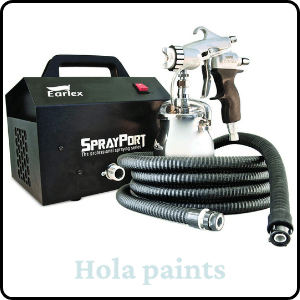
HVLP sprayers deliver high air volume (10-30 CFM) at low pressure (10 PSI or more). In this system, atomization occurs by air volume not because of air pressure, which reduces the forward velocity and results in a softer spray.
The softer spray allows the material to stick to the part more and not bounce off into the air, thus causing less air pollution and paint waste. Moreover, the market offers two HVLP options.
One is Turbine-powered, while the other is Pneumatic spray guns. Therefore, beginners and inexperienced DIYers will efficiently operate HVLP spray guns because of their user-friendly design and easy work mechanism. Here is an in-depth review of HVLP spray guns that I have used for many projects.
HVLP Turbines
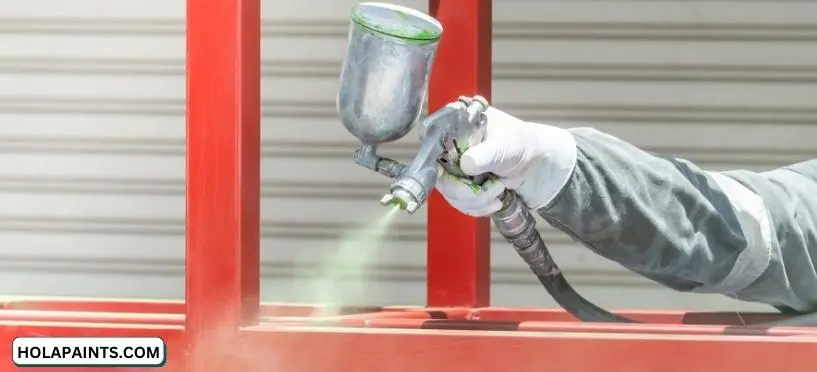
The most popular power-painting tool among professionals is HVLP turbines. The HVLP units come in handheld models such as HomeRight Finish Max sprayer that feature an integrated turbine powerhouse. You can also buy floor-standing machines with an external power unit.
Plus, the medium-scale applications of HVLP turbines include waterproofing decks, painting fences, upgrading furniture, doors and trims.
Pneumatic Guns
An external compressor is required for pneumatic HVLP guns to atomize and propel your coating medium. The paint density, air volume, and pressure can be adjusted, making them versatile than turbines. Because of this reason, they’re preferred by contractors.
However, these sprayers are more costly than HVLP turbines. Also, pneumatic units require considerable setup time and need some experience to operate.
PROS:
CONS:
LVLP Meaning
Low volume Low-pressure sprayers have the combination of the best features of HVLP and conventional air sprayers.
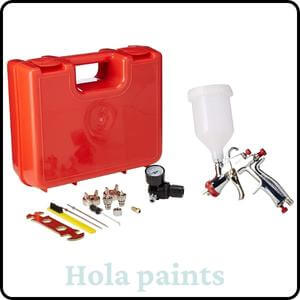
They are only available as compressor-driven units. These sprayers create better atomization to produce quality finishes.
LVLP spray guns requires very little air pressure for operation, so a small air compressor can be used.
Air consumption for this spray gun ranges from 3.5CFM to 3.9CFM at 30 psi. The optimal working pressure ranges from 25 to 45 psi.
I’ve tested LVLP spray guns for different projects in this year, so you can read the review of these models to learn more about them.
PROS:
CONS:
Comparison Factors Of LVLP vs HVLP Spray Gun
1. Transfer Efficiency
Depending on the model of the spray gun, paint transfer efficiency also differs depending on HVLP or LVLP sprayers.
The transfer efficiency rate of an HVLP paint sprayer such as Wagner 590 or Wagner control spraytech ranges from 60 to 65 percent. However, some manufacturers state that their products are capable of delivering up to 75 percent.
The performance of HVLP is better than other painting methods, such as brushes and rollers, but in terms of efficiency, LVLP still beats HVLP.
On the other hand, LVLP is a cost-efficient option for painters like Sprayit 33000 and 33500 spray gun, and it offers transfer efficiency of up to 70 to 80%. So, there is less paint spreading all over the place when using LVLP.
Plus, It is more eco-friendly to use LVLPs than HVLPs since they generate less waste, save more money, and are less expensive.
2. Project Scale Size ( hVLP vs lVLP vs Airless )
HVLP sprayers (pneumatic or turbine) are excellent for small to medium projects— exterior or interior walls, decking, furniture, and cabinet spraying.
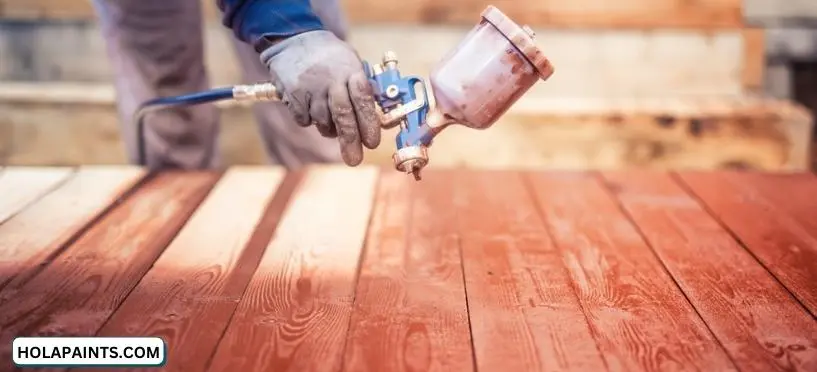
If you wish to perform larger painting projects, then you should prefer an Airless sprayer. Airless machines provide better coverage than either LVLP or HVLP sprayers, but with only about 50% transfer efficiency.
However, LVLP sprayers have a smaller fan pattern than HVLP turbines, usually between 8 and 10 inches, so they tend to take more time to complete medium-sized projects.
LVLP units are popular for fine-finishing work because of their low overspray, thin coverage, and quality finish. Many car spraying professionals prefer LVLP systems for this reason.
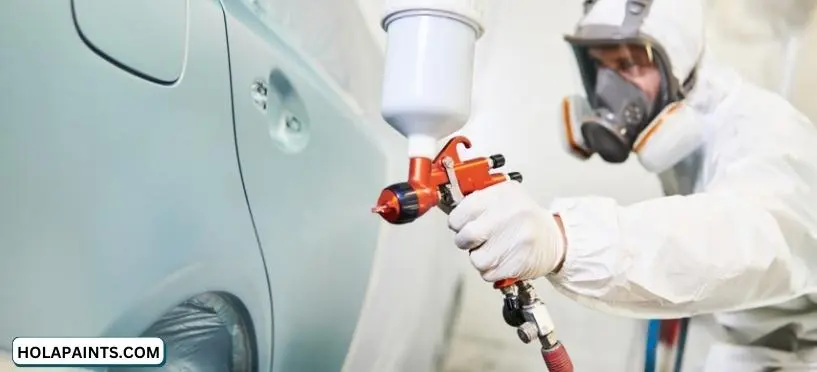
3. Compatibility With Compressor
HVLP turbines do not require a compressor. On the other hand, If you decide to buy a Pneumatic HVLP gun, then you need the correct compressor; otherwise, your paint will be nothing but a drip.
The output of a compressor is typically measured in PSI and CFM. The pressure required by an HVLP pneumatic spray gun is around 15 to 35 PSI, so most home compressors can provide it.
CFM is another essential factor that you cannot ignore. Be sure to check the manufacturer’s specifications for the gun you intend to use. HVLP guns require more than 10-25 CFM than other guns, so users must size their air compressor accordingly.
To learn more about the technical issue, please read the basics about compressor requirements.
LVLP spray guns require a lower PSI to operate correctly (10 PSI), so you can use almost any air compressor, and it will work fine.
Even the cheapest air compressor will work for LVLP spray guns. But using a cheap and low-quality air compressor is not recommended since the air compressor is one of the most important factors contributing to the spray gun’s performance.
In contrast, LVLP guns require a CFM range of 5-18 due to the low pressure. Hence, the LVLP unit sprays faster, atomizes better, and uses less airflow to accomplish quality finishing.
4. Painting Mediums– What type of paint is best for HVLP or LVLP?
HVLP creates a good finish, though it is not quite as impressive as LVLP. Metallic paints and thicker materials works great with HVLP paint system. However, most paint materials still need to be diluted to get a suitable viscosity.
You can spray a wide range of materials like enamel, acrylic, primer, paint, stain, and even Latex with turbine HVLP sprayers.
While pneumatic HVLP guns are usually compatible with multi-coatings and can propel viscous fluids with proper thinning requirements, at this stage, selecting the spray tip is also an important consideration. The large diameters are better suited for paints with a thicker consistency, like Latex.
On the other hand, LVLP sprayers are not recommended if you wish to paint thicker material. It works best for thin materials such as varnish, clear coats, thin stains, and lacquers. As per my experience, LVLP is not good for latex paints.
The problem persists with standard latex paints, even when thinned considerably because LVLP sprayers can operate on smaller compressors and requires less air pressure. An LVLP system generally uses ten psi or less. Thus, LVLP guns are a perfect fit for home systems.
5. Value For Money
HVLP turbine sprayers are the best value option for beginners and casual DIYers in the marketplace because they don’t require an additional compressor. Unlike turbines, pneumatic spray guns require a compressor, which makes them more expensive.
In contrast, LVLP machines are a more cost-effective option than HVLP machines, which require high volumes.
How to set up and use your LVLP spray gun?
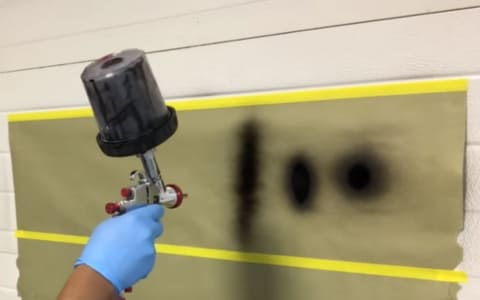
In this section, it is all about setting up my paint gun, specifically LVLP (Low Volume Low Pressure) ones. I have got my compressor sorted out, and now I am ready to get that air flowing for a perfect spray. Let’s dive into setting up the spray gun.
There are three controls we need to be familiar with:
- Top Control: Adjusts the fan pattern.
- Middle Control: Manages the fluid flow, determining how much material comes out.
- Air Control: Regulates air pressure, and we’ll use an air regulator for this.
Now, let’s set up the spray gun step by step:
- Air Control: Open it wide since we’re using an air regulator. We’ll adjust the pressure later with the regulator.
- Fluid Control: Turn it all the way out, then squeeze the trigger and gradually turn it in until you feel the needle against the trigger for full fluid.
- Fan Control: Start with the fan closed completely. Open it gradually until you get the desired fan pattern.
Keep in mind:
- Adjust the air pressure with the regulator.
- Be cautious with the fan pattern to avoid too much overspray or running the material.
- Aim for a football-shaped pattern, about 5 to 7 inches away.
How do you spray paint with a HVLP gun?
I’m sharing the process of painting with an HVLP spray gun. Let’s start with breaking down the basic controls and then move on to some demonstrations of painting techniques.
Parts Breakdown:
The HVLP spray gun typically consists of several parts: the cup, nozzle, fan control, paint volume control, air volume control, air inlet, trigger, and needle. Understanding these components is crucial for efficient use.
Cleaning:
Before you begin, it’s essential to disassemble the gun for cleaning. Parts like the cup, nozzle, and needle need to be scrubbed thoroughly to ensure a clean application. Pay attention to ports and ensure they’re clear.
Needle Options:
HVLP guns often come with multiple needle options, like 1.4 and 1.8, suitable for different paint viscosities. Picking the right needle is crucial for the perfect finish.
Fan Control:
The fan control adjusts the width of your spray pattern. Closed gives you a circle pattern, while open provides a wider fan. This control is crucial for adapting to different painting scenarios.
Paint Volume Control:
This control paint flow by starting with a low volume and adjusting gradually. It’s easier to add more paint later than deal with excess.
Air Pressure:
Maintaining the correct air pressure is crucial. Too low, and you get speckles; too high, and you get overspray. Finding the sweet spot, usually around 35 psi, is key for a good finish.
Paint Filtering:
Before you start, always filter your paint to remove any impurities. Ensure a smooth application by filtering paint to remove particles.
Painting Techniques:
When painting, consider the distance between the gun and the surface. Adjust the fan pattern based on what you’re working on—tighter for small parts, wider for larger areas. Explore varied pressures and volumes to find your project’s best settings.
Is HVLP good for painting cars?
It is possible to paint cars (including car hood, bumper painting)with HVLP spray guns, but they may not be the best option for certain types of automotive painting.
Generally, HVLP spray guns produce fine finishes with minimal overspray, making them suitable for painting cars where a smooth, high-quality finish is required. However, HVLP guns need large volumes of air to operate, which can be challenging in a home garage or small body shop.
The price of HVLP guns can also be higher than other types of spray guns for some automotive painting projects. On the other hand, heavy-duty industrial applications and larger surfaces can be covered with LVLP spray guns.
HVLP vs LVLP for Latex Paints
LVLP has a fine-atomized spray that is great for clear coats, single stage enamels and painting vehicles. It also paints at a slower rate than an HVLP, which is great for detail painting. However, an HVLP is ideal for thinned paints like latex and also paints more quickly than an LVLP.
LVLP Vs HVLP for Woodworking
When it comes to woodworking, both LVLP and HVLP spray guns have their advantages. LVLP guns, with lower air volume, are often favored for smaller woodworking projects due to reduced overspray and precise application.
On the other hand, HVLP guns, offering a higher volume of air, excel in larger projects, providing efficient coverage with minimal waste. The choice depends on project scale and desired finish. LVLP suits intricate details, while HVLP shines in larger surface applications, making them versatile tools for woodworkers seeking optimal results in various scenarios.
Can you spray primer with LVLP?
Yes, you can use an LVLP spray gun with a 1.8mm nozzle size or larger to apply primer effectively. LVLP guns, even with larger nozzles, are suitable for laying down high-build primer. When using an LVLP spray gun for primer application, it’s important to adjust settings, follow manufacturer’s guidelines, and ensure proper surface preparation.
Additionally, in outdoor settings, using high pressure or RP guns to reduce overspray is common, and thinning the primer slightly can improve its sprayability.
Trans tech vs HVLP
Trans-Tech and HVLP represent two distinct technologies employed in spray guns for various applications. Let’s delve into each:
HVLP :
Operation: HVLP spray guns utilize a high volume of air at low pressure, creating a softer spray pattern that minimizes overspray and enhances transfer efficiency.
Ideal Uses: Suited for precision applications where reduced overspray is essential, such as automotive painting, woodworking, and furniture finishing.
Paint Types: HVLP systems are effective with water-based paints, lacquers, and latex paints due to their lower viscosity.
Trans-Tech:
Operation: Trans-Tech, or Transfer Efficiency Technology, focuses on optimizing paint transfer from the gun to the surface. It operates as a type of conventional spray gun, adjusting the balance between pressure and air volume.
Ideal Uses: Commonly employed in industrial settings and scenarios requiring a balance between efficiency and a traditional spray pattern.
Paint Types: Trans-Tech guns offer versatility, handling a range of paints, including solvent-based and water-based options, catering to different application needs.
HVLP vs LVLP Bottom Line:
When comparing HVLP vs LVLP, there is no clear winner since it all depends on your spraying needs. You may find an HVLP unit most helpful if you’re an inexperienced user and aim to complete various minor home improvements tasks. Or, in any case, if you do not choose an HVLP turbine model, then you will need a compressor for spray painting.
In contrast, an LVLP gun is also a great option when you want to apply a variety of coatings, especially on automobiles.
We hope you have gained a more precise understanding of the differences between HVLP and LVLP spray guns. It will now be easier for you to select the right spray gun for your specific needs.
FAQs about HVLP vs LVLP
Q: For what purpose is an LVLP spray gun used?
You should consider LVLP sprayers if you look for a compact unit that will deliver a fast finish with little overspray. You can use LVLP sprayers for a wide range of tasks, including painting automobiles. Plus, the LVLP gun is perfect for applying clear coats.
Also, this type of spray gun is suitable for high viscosity coatings and waterborne paints. However, if you are less experienced in this field, you might not get the best results – you will need a fair amount of knowledge of LVLP guns as you will be applying high-quality materials.
Q: HVLP or LVLP: Which is better?
HVLP and LVLP are high-end professional spray guns; choosing between them will depend on the following factors:
- HVLP turbines, especially the handheld versions, are ideal for beginners and homeowners. It demands little-to-no experience. In addition, LVLP spray guns are best suited to professionals for small-to-medium painting projects.
- HVLP’s are highly versatile and can handle thin mediums. Spray guns with HVLP technology produce a good finish with little paint waste, making them a cost-effective choice for small to medium projects.
- On the other hand, LVLP paint sprayers are highly rated by painting professionals. They only require a small compressor which is suitable for clear coat, base coat, enamels and stains. These spray guns are ideal for fine details since it paints slowly compared to an HVLP.
- The LVLP spray guns provide excellent atomization, which means they spray faster and give a superior finish for automobile painting projects. Keep in mind; you don’t have to be a pro to appreciate these sprayers. You can also try them yourself to see if LVLPs are an excellent choice for your next project.
Q: Can an LVLP gun be used to paint a car?
Yes, definitely. Painting cars is one of the many applications for LVLP sprayers. You can apply both clear coats and metallic with LVLP guns.
Q: Is the HVLP gun better than other guns?
Yes, HVLP guns generally have better efficiency at transferring material, making them perfect for small to midsized projects that requires a high-quality finish. HVLP systems enable experienced painters to work at about 60% efficiency, which means less paint waste and fewer cleanups because more paint sticks to the surface.
Q: Do gravity feed spray guns work better?
Gravity-feed spray guns use less air pressure and offer efficiency and versatility, making them an ideal choice for beginners and pros. The advantage of gravity-fed spray guns is that they are generally simpler to use and lightweight. Plus, you can use all the paint from the container with these guns.

Jennifer Marie
Jennifer Marie is a general contractor with over the years of experience in home remodeling, DIY projects, and commercial painting projects. Her experience includes working with paint sprayers, painting tools, and other painting supplies. You can follow her on Facebook.

